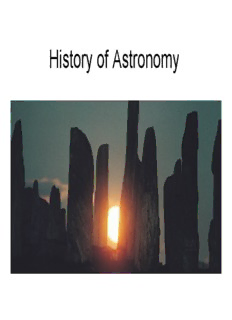
© 2005 Pearson Education Inc., publishing as Addison-Wesley PDF
Preview © 2005 Pearson Education Inc., publishing as Addison-Wesley
History of Astronomy © 2005 Pearson Education Inc., publishing as Addison-Wesley Ancient Astronomy What did ancient civilizations use astronomy for? daily timekeeping • • tracking the seasons and calendar • monitoring lunar cycles • monitoring planets and stars • predicting eclipses • and more… © 2005 Pearson Education Inc., publishing as Addison-Wesley Discovering the Universe for Yourself (what we see when we look up) 1 Patterns in the Sky > Motions in the Sky 2 The Circling Sky > the rotation of the Earth about its axis 3 The Reason for Seasons > the Earth’s orbit around the Sun 4 Precession of the Earth’s Axis > the wobbling of Earth’s axis 5 The Moon, Our Constant Companion > the Moon’s orbit around the Earth 6 The Ancient Mystery of the Planets > the various plane©ts 2’0 0o5r Pbeiatrss oanr Eoduuncadti otnh Ienc S., un publishing as Addison-Wesley © 2005 Pearson Education Inc., publishing as Addison-Wesley Ancient people of central Africa (6500 B.C.) could predict the seasons from the orientation of the crescent moon near the western horizon © 2005 Pearson Education Inc., publishing as Addison-Wesley © 2005 Pearson Education Inc., publishing as Addison-Wesley • Egyptian obelisk: shadows tell time of day. © 2005 Pearson Education Inc., publishing as Addison-Wesley England: Stonehenge (completed around 1550 B.C.) © 2005 Pearson Education Inc., publishing as Addison-Wesley England: Stonehenge (completed around 1550 B.C.) © 2005 Pearson Education Inc., publishing as Addison-Wesley SW United States: “Sun Dagger” marks summer solstice © 2005 Pearson Education Inc., publishing as Addison-Wesley
Description: